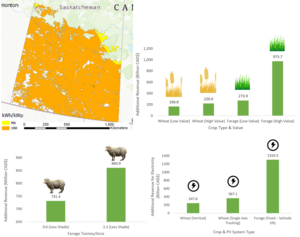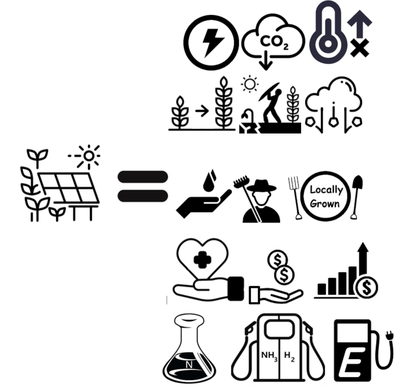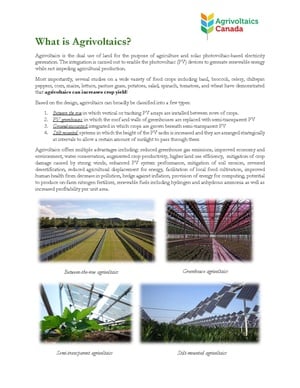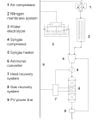
Canada is a leading global agricultural exporter, and roughly half of Canada’s farmland is in Saskatchewan. New agrivoltaics research shows increased biomass for a wide range of crops. This study looks at the potential increase in crop yield and livestock in Saskatchewan through agrivoltaics along with its financial implications. Then, the legislation that could influence the adoption of agrivoltaics in Saskatchewan is reviewed. Specifically, experimental results from agrivoltaic wheat production are analyzed for different adoption scenarios. The impact of converting the province’s pasture grass areas to agrivoltaics and using sheep to harvest them is also examined. The results indicate that approximately 0.4 million more tons of wheat, 2.9 to 3.5 million more tons of forage and 3.9 to 4.6 million additional sheep can be grazed using agrivoltaics in Saskatchewan. Only these two agrivoltaics applications, i.e., wheat farmland and pastureland, result in potential additional billions of dollars in annual provincial agricultural revenue. The Municipalities Act and the Planning and Development Act were found to have the most impact on agrivoltaics in the province as official community plans and zoning bylaws can impede diffusion. Agrivoltaics can be integrated into legislation to avoid delays in the adoption of the technology so that the province reaps all of the benefits.
See also[edit | edit source]


- Coal with Carbon Capture and Sequestration is not as Land Use Efficient as Solar Photovoltaic Technology for Climate Neutral Electricity Production
- Dual use of land for PV farms and agriculture literature review
- sheep
- Israeli white plastic reflectors
- A Farmer's Guide to Going Solar (NREL)
- German guidelines: https://www.ise.fraunhofer.de/content/dam/ise/en/documents/publications/studies/APV-Guideline.pdf
- 2021 review
- Miskin, C.K., Li, Y., Perna, A., Ellis, R.G., Grubbs, E.K., Bermel, P. and Agrawal, R., 2019. Sustainable co-production of food and solar power to relax land-use constraints. Nature Sustainability, 2(10), pp.972-980.
- Retrofitting solar parks for agrivoltaics
- Shading PV
- Alexis' talk at American Solar Grazing Association2021
In the News[edit source]
- Agrivoltaics: solar energy + better crops Climate and Nature
- Why solar power and farmers’ fields could be the perfect combination TVO
- Solar farms and sheep show the makings of a clean energy classic duo Business Renewables
- Agrivoltaics charge up St. Albert-area farms St Albert Gazette
- Sheep, solar and crops. How some Alberta farms are creating ideal growing conditions Western Wheel
- Sheep, solar and crops. How some Alberta farms create ideal growing conditions Voxpopuli
- 3D printed clamps for front-surface PV mounting on wood racking PV Magazine
- Harvesting the Sun to Grow in the Shade Garden Culture Magazine
- What crops fit with vertical agrivoltaics? PV Magazine
- Agrivoltaics – Keeping the farm in the solar farm Green Energy Futures
- Solar
- Papers
- Agrivoltaics
- Solar power
- Solar energy
- Photovoltaics
- Sustainable development
- Agriculture
- SDG02 Zero hunger
- SDG07 Affordable and clean energy
- SDG08 Decent work and economic growth
- SDG09 Industry innovation and infrastructure
- SDG12 Responsible consumption and production
- Canada
- Energy
- Energy policy
- Farming
- Land use
- Renewable energy
- FAST Completed
- Sustainability






































